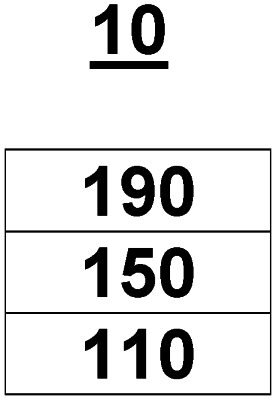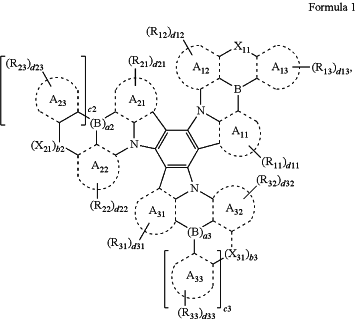| CPC H10K 85/322 (2023.02) [C07F 5/027 (2013.01); C09K 11/06 (2013.01); H10K 85/657 (2023.02); C09K 2211/1018 (2013.01); H10K 50/11 (2023.02)] | 20 Claims |

|
1. An organic light-emitting device comprising:
a first electrode;
a second electrode facing the first electrode;
an organic layer between the first electrode and the second electrode and comprising an emission layer; and
a heterocyclic compound represented by Formula 1:
 wherein, in Formula 1,
rings A11 to A13, rings A21 to A23, and rings A31 to A33 are each independently a C5-C30 carbocyclic group or a C2-C30 heterocyclic group,
X11 is O, S, N(R11a), C(R11a)(R11b), or Si(R11a)(R11b),
X21 is O, S, N(R21a), C(R21a)(R21b), or Si(R21a)(R21b),
X31 is O, S, N(R31a), C(R31a)(R31b), or Si(R31a)(R31b),
a2 is 0 or 1, and when a2 is 0, a corresponding boron atom is not present,
b2 is 0 or 1, and when b2 is 0, X21 is not present,
c2 is 0 or 1, and when c2 is 0, ring A23 is not present,
a3 is 0 or 1, and when a3 is 0, a corresponding boron atom is not present,
b3 is 0 or 1, and when b3 is 0, X31 is not present,
c3 is 0 or 1, and when c3 is 0, ring A33 is not present,
R11a, R11b, R21a, R21b, R31a, R31b, R11 to R13, R21 to R23, and R31 to R33 are each independently selected from hydrogen, deuterium, —F, —Cl, —Br, —I, a hydroxyl group, a cyano group, a nitro group, an amidino group, a hydrazine group, a hydrazone group, a substituted or unsubstituted C1-C60 alkyl group, a substituted or unsubstituted C2-C60 alkenyl group, a substituted or unsubstituted C2-C60 alkynyl group, a substituted or unsubstituted C1-C60 alkoxy group, a substituted or unsubstituted C3-C10 cycloalkyl group, a substituted or unsubstituted C2-C10 heterocycloalkyl group, a substituted or unsubstituted C3-C10 cycloalkenyl group, a substituted or unsubstituted C2-C10 heterocycloalkenyl group, a substituted or unsubstituted C6-C60 aryl group, a substituted or unsubstituted C6-C60 aryloxy group, a substituted or unsubstituted C6-C60 arylthio group, a substituted or unsubstituted C1-C60 heteroaryl group, a substituted or unsubstituted monovalent non-aromatic condensed polycyclic group and a substituted or unsubstituted monovalent non-aromatic condensed heteropolycyclic group, —Si(Q1)(Q2)(Q3), —N(Q1)(Q2), —B(Q1)(Q2), —C(═O)(Q1), —S(═O)2(Q1), and —P(═O)(Q1)(Q2),
d11 to d13, d21 to d23, and d31 to d33 are each independently an integer from 0 to 10,
at least two selected from R11a, R11b, R21a, R21b, R31a, R31b, R11 to R13, R21 to R23, and R31 to R33 are optionally bound to form a C5-C30 carbocyclic group that is unsubstituted or substituted with at least one R10a, or a C2-C30 heterocyclic group that is unsubstituted or substituted with at least one R10a,
R10a is the same as described in connection with R11, and
at least one substituent of the substituted C1-C60 alkyl group, the substituted C2-C60 alkenyl group, the substituted C2-C60 alkynyl group, the substituted C1-C60 alkoxy group, the substituted C3-C10 cycloalkyl group, the substituted C1-C10 heterocycloalkyl group, the substituted C3-C10 cycloalkenyl group, the substituted C1-C10 heterocycloalkenyl group, the substituted C6-C60 aryl group, the substituted C6-C60 aryloxy group, the substituted C6-C60 arylthio group, the substituted C1-C60 heteroaryl group, the substituted monovalent non-aromatic condensed polycyclic group, and the substituted monovalent non-aromatic condensed heteropolycyclic group is selected from:
deuterium (-D), —F, —Cl, —Br, —I, a hydroxyl group, a cyano group, a nitro group, an amidino group, a hydrazine group, a hydrazone group, a C1-C60 alkyl group, a C2-C60 alkenyl group, a C2-C60 alkynyl group, and a C1-C60 alkoxy group;
a C1-C60 alkyl group, a C2-C60 alkenyl group, a C2-C60 alkynyl group, and a C1-C60 alkoxy group, each substituted with at least one selected from deuterium, —F, —Cl, —Br, —I, a hydroxyl group, a cyano group, a nitro group, an amidino group, a hydrazine group, a hydrazone group, a C3-C10 cycloalkyl group, a C1-C10 heterocycloalkyl group, a C3-C10 cycloalkenyl group, a C1-C10 heterocycloalkenyl group, a C6-C60 aryl group, a C6-C60 aryloxy group, a C6-C60 arylthio group, a C1-C60 heteroaryl group, a monovalent non-aromatic condensed polycyclic group, a monovalent non-aromatic condensed heteropolycyclic group, —Si(Q11)(Q12)(Q13), —N(Q11)(Q12), —B(Q11)(Q12), —C(═O)(Q11), —S(═O)2(Q11), and —P(═O)(Q11)(Q12);
a C3-C10 cycloalkyl group, a C1-C10 heterocycloalkyl group, a C3-C10 cycloalkenyl group, a C1-C10 heterocycloalkenyl group, a C6-C60 aryl group, a C6-C60 aryloxy group, a C6-C60 arylthio group, a C1-C60 heteroaryl group, a monovalent non-aromatic condensed polycyclic group, and a monovalent non-aromatic condensed heteropolycyclic group, each independently unsubstituted or substituted with at least one selected from deuterium, —F, —Cl, —Br, —I, a hydroxyl group, a cyano group, a nitro group, an amidino group, a hydrazine group, a hydrazone group, a C1-C60 alkyl group, a C2-C60 alkenyl group, a C2-C60 alkynyl group, a C1-C60 alkoxy group, a C3-C10 cycloalkyl group, a C1-C10 heterocycloalkyl group, a C3-C10 cycloalkenyl group, a C1-C10 heterocycloalkenyl group, a C6-C60 aryl group, a C6-C60 aryloxy group, a C6-C60 arylthio group, a C1-C60 heteroaryl group, a monovalent non-aromatic condensed polycyclic group, a monovalent non-aromatic condensed heteropolycyclic group, —Si(Q21)(Q22)(Q23), —N(Q21)(Q22), —B(Q21)(Q22), —C(═O)(Q21), —S(═O)2(Q21), and —P(═O)(Q21)(Q22); and
—Si(Q31)(Q32)(Q33), —N(Q31)(Q32), —B(Q31)(Q32), —C(═O)(Q31), —S(═O)2(Q31), and —P(═O)(Q31)(Q32),
wherein Q1 to Q3, Q11 to Q13, Q21 to Q23, and Q31 to Q33 are each independently selected from:
hydrogen; deuterium; —F; —Cl; —Br; —I; a hydroxyl group; a cyano group; a nitro group; an amidino group; a hydrazine group; a hydrazone group; a C1-C60 alkyl group; a C2-C60 alkenyl group; a C2-C60 alkynyl group; a C1-C60 alkoxy group; a C3-C10 cycloalkyl group; a C1-C10 heterocycloalkyl group; a C3-C10 cycloalkenyl group; a C1-C10 heterocycloalkenyl group; a C6-C60 aryl group; a C1-C60 heteroaryl group; a monovalent non-aromatic condensed polycyclic group; a monovalent non-aromatic condensed heteropolycyclic group; a C1-C60 alkyl group substituted with at least one selected from deuterium, —F, and a cyano group; a C6-C60 aryl group substituted with at least one selected from deuterium, —F, and a cyano group; a biphenyl group; and a terphenyl group.
|